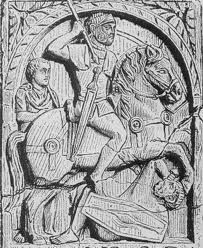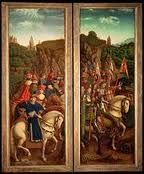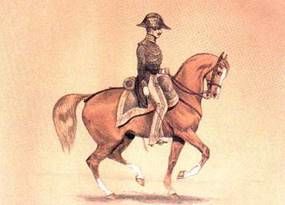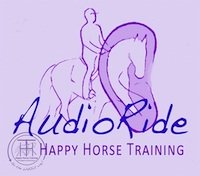|
The Origins of Dressage TrainingIt is interesting to consider the history of dressage training in order to understand the background and context of this gymnastic art. Man's relationship with the Horse began many millennia ago, and it has been a crucial part of our development as a species. The practice of riding horses is estimated at having begun between 6000 and 4000 BC. However dressage as a considered approach to training horses for riding began with the Ancient Greeks, in particular the Athenian Cavalry Commander Xenephon, who is responsible for the first recorded writings on dressage training. He wrote his treatise 'on the Art of Horsemanship' in 360 BC. 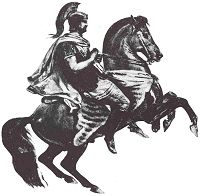
Xenephon (right) was the first known trainer to understand the importance of the rider's position to dressage training, and to apply a more intelligent and compassionate approach to the horse compared to the methods of other horsemen of the era.
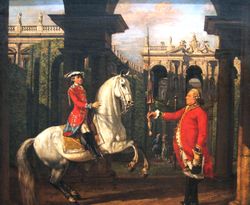
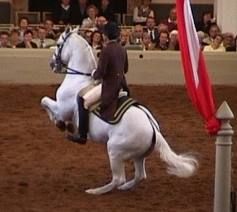
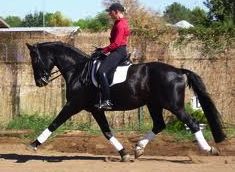
This has brought about a great change in the type of horse favored for dressage: from the compact Iberian type suited to collection and the high-school airs (above right), to the large and powerful warmblood (below right), developed for its capacity for spectacular extension. Although modern dressage has developed into a specialized equestrian sport, it should still be seen as the foundation for all the equestrian disciplines, being the means by which the horse is straightened and brought into balance with the rider so that the horse's full power can be applied to any activity. There is still a significant divide between the classical school of Dressage training, and the competitive approach. It is interesting to consider the origins of this difference. As a result of the military foundations of Classical dressage, certain practical considerations played an important role in the training methods developed:
In modern competition-orientated dressage training, these values are no longer relevant because they won't necessarily add to your competitive success. For example, it doesn't matter if a top rider's horse only lasts until the age of 15 before breaking down, there is always another up-and-coming prospect to achieve more success. Neither does the modern horse have to posses the resilience and genuine submission to be able to take its rider into battle. It is perfectly accepted for modern dressage horses to be held in and controlled by the bit, as the rider only needs to take the hand off the rein for the moment that he removes his hat to salute at the beginning of the test, and of course to wave to the crowd at the end. Therefore the independent seat effectively becomes an irrelevance. Finally, the character that is encouraged by the competitive environment is essentially the pursuit of winning above all else, including the welfare of the horse.
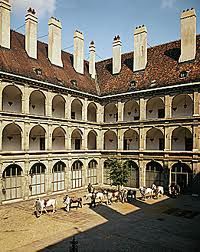
This is perhaps partly because the great dressage schools of the renaissance in France and Italy, where the nobility rode, were usually situated in large cities, so horses in training were permanently stabled with no possibility for freedom or social interaction (for example the stables of the Spanish Riding School of Vienna, illustrated here). Of course this situation has not changed for most modern dressage horses. This is why we have to put our focus on doing things in the right way, intelligently, instead of adhering to some particular school of thought. Horses being ridden with hollow backs are just as common in Classical dressage as in competitive dressage, and there has been good and bad riding throughout all periods of the history of dressage. We have to remember that no matter how much we study and admire the great masters of the past, Dressage training is not an intellectual activity. It is a living art which can only be preserved by individuals who take the time and effort to learn the unique gymnastic skills involved, and pass their understanding on to others through good teaching. The principles of true engagement are universal and apply to any horse, no matter what its breed, purpose or era in history, and this engagement, achieved by intelligent dressage training, is the most profound connection that it is possible for man to achieve with the horse. Relevent pages on Happy Horse Training that may interest you: return from The Origins of Dressage Training to Happy Horse Training home |
New from HHT!
AudioRide is a series of exercises designed to listen to while you ride.
Audio descriptions guide you through each step of developing a balanced, dynamic connection with the horse through your position.
This truly innovative learning tool gives you a whole new way of being guided in your riding, in a calm, clear, step-by-step way.
Free Download! Introductory Exercise: Riding in the Now
Click here for full details
The Gymnastic Rider eBook
Now available exclusively from HHT! A unique, comprehensive guide to practical rider biomechanics. This professionally produced eBook takes the rider through the process of developing their body in the specific way that brings the horse's movement into harmony and balance - without force and constraint. Click here for full details, and to download the 15-page introduction for free.
Join the Happy Horse Training group on Facebook!
See and share topical info, news and photo's, and take part in lively discussions.
Click here to go to the HHT group and then click on the 'join group' button.
Join the Whole Horse Newsletter
HHT's free monthly newsletter giving you wide-ranging and intelligent insights into holistic horsemanship.
Just enter your details below to join.
Free bonus on the riding position with all new subscriptions: Ten Top Tips To Instantly Improve Your Connection With Your Horse.
Click here to see back issues of The Whole Horse newsletter
Train Your Horse
The Holistic Way
How To Train A Horse Without Force is a unique guide to training horses through energetic connection and gymnastic training. Part 1 covers everything on the ground, from handling to the lungeing technique that develops strength, straightness and engagement. Comes with a free eBook supplement on Horse Trauma.
Click here for more details.
What people say about the eBook:
"OMG! I'm BLOWN AWAY by this text [...] It's one of the best horse training texts I've ever read." - Wendy Kendall
"I realized that I haven't yet written you about the impact that your training e-book has had on me, and I want to let you know how inspiring and helpful I found it. As a student of Zen Buddhism for nearly three decades, I've often wondered when someone was going to write the book on Zen and the art of horsemanship, and I think that your emphasis on mindfulness and energy connection gets right at the heart of the matter. It has certainly deepened the way that I relate to and communicate with my horses. I am reasonably sensitive to horses' body language and mood, but new to me was the idea of feeling their energy in a more subtle way - including their connection with me even when I am not directly working with the them. I have made myself more aware of this communication, and it's pretty amazing. I have started grooming differently, too, treating a grooming session as a time to mindfully listen to my horse instead of a way to dust out an old rug (OK, I wasn't quite that bad, but you get the idea). Additionally, I have made myself more open to how I actually feel about the horses themselves - very enlightening. Overall, I think that you are saying something that no one else is saying but that everyone ought to hear." - Tess Lloyd
Do You Have
A Horse Story
To Share On HHT?
So many people have been through wonderful experiences with horses, whether in training or otherwise. If you've made a change in a horse's life - or one has made a change in yours - tell us about it here.
Learn How To Trim
Your Own Horse's Feet
The Simple Seven-Step Natural Trim is a comprehensive step-by-step guide to a cutting-edge barefoot trim. Click here to find out more.
What people say about HHT:
"The riding instruction is outstanding, if instructors in the UK taught this way there would be a lot of happy riders and horses."
"The riding tuition exceeded my hopes and expectations by a long way; giving me an exciting new facet to horsemanship which is lighter. more subtle, more elegant and more meaningful. It is as if a new door has opened bringing more sunlight and air."
"My goodness - what a change has taken place in my riding. I think that I'm starting to sit 'into' the horse rather than on top of him. I felt my horse's movements in a way that has almost never happened before"
Click on Testimonials for more





